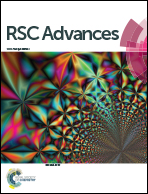Photocatalytic performance of Ag2S under irradiation with visible and near-infrared light and its mechanism of degradation†
Abstract
Ag2S has only rarely been investigated as a photocatalyst on its own, although it has been widely used as an important component of composite photocatalysts. We synthesized Ag2S by a facile ion-exchange method at room temperature and used it directly as an effective photocatalyst. Our results confirmed the excellent performance of Ag2S in completely photodegrading methyl orange within 30 min under irradiation with visible light and within 70 min under irradiation with near-infrared light. This good performance is ascribed to the narrow band gap (1.078 eV) of Ag2S and the lower recombination efficiency of the photogenerated electron–hole pairs of Ag2S in the photocatalytic process. The active species in the photo-oxidation process was identified as anioic ozone radicals. This simple preparation method and high photocatalytic performance increases the possible future applications of Ag2S.


 Please wait while we load your content...
Please wait while we load your content...